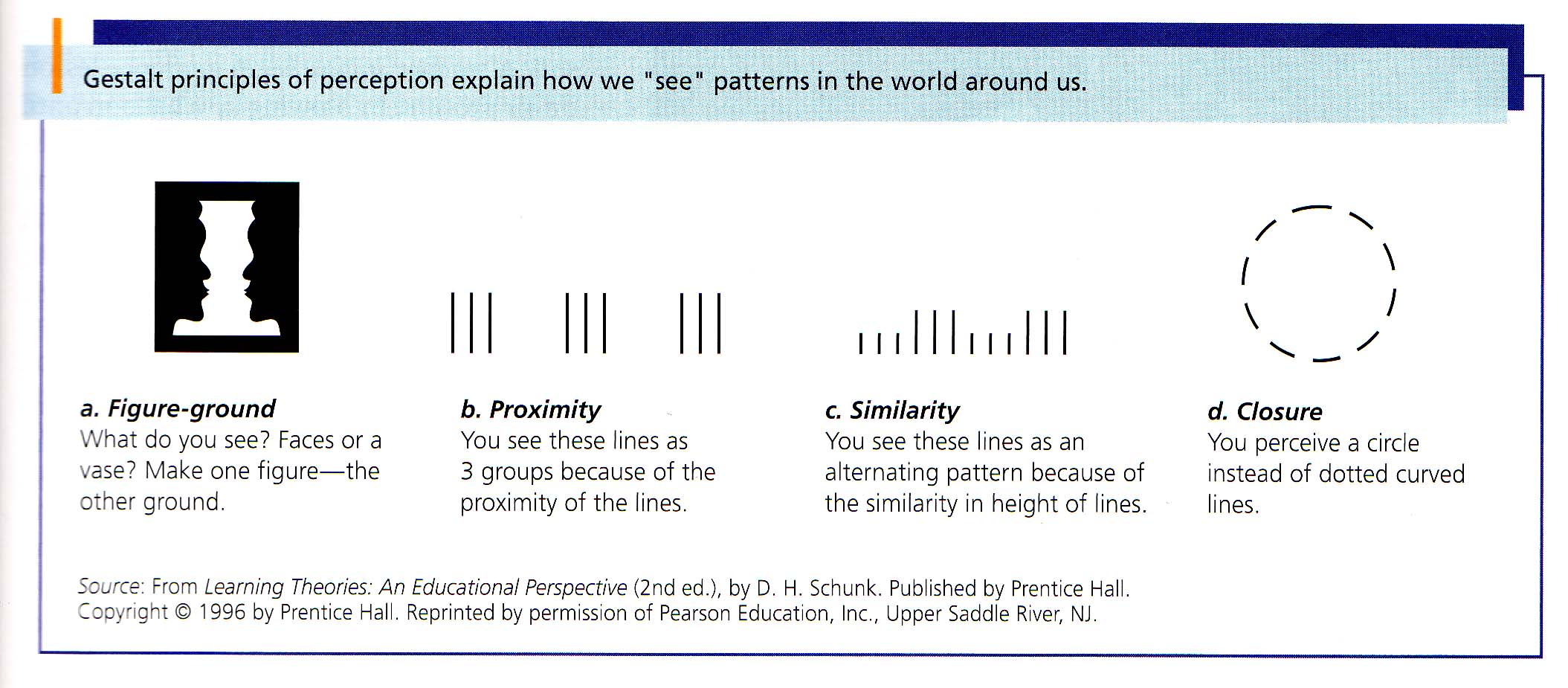Lesson 10 Processing Styles
You may also check your understanding of the material on the Ablongman web site. Click on the Publisher Help Site button.
![]()
Presentation of Theoretical Construct
![]()
Lecture Information: Art of Perception
The concept of perception for humans has proven to be a very important topic. A whole branch of psychology started from this concept. It was noted by earlier psychologists that everyone's view of reality was fundamentally unique to them. It was proposed that objects had no inherent meaning in and of themselves, but the viewer of that object who attached a meaning to the object. This act of attaching meaning to a given stimulus in our own particular way, is what is known as perception to psychologists. It is this uniqueness that inspired a third branch of psychology called phenomenology. That is to say that there is really no way for any of us to truly experience what another person is experiencing. We can only have a representation of what their experience is based on our interpretation of what we see and have seen in our lives.
One of the most profound beliefs centers on how information is processed by people. In phenomenological approaches there is a supposition of a figure-ground cognitive activity. That is to say that given the bombardment of sensory input that hits us during all of our waking moments, there is a "figure" that emerges to focus our attention on. For example, as you are reading this sentence, you are probably not even aware of ambient sounds, fans, air conditioners, heaters, clocks, etc., of your house, office, or computer lab until I just mentioned them to you. Hopefully, my words are the figure and the all the rest fades to (back) "ground." There is also the phenomena of "closure" playing a uniquely human role as well. We have sense-making machines between our ears. Our brains actually work as probability wizards in that given incomplete information on virtually all occasions, we have a large degree of certainty about our conclusions. Our brains fill in the missing parts of information in order to make sense of the world. It is the only way we could live efficiently.

Processing Styles:
-
Bottom/Up:
-
This style of Processing is often also referred to as "Feature Analysis." A bottom/up person is one who naturally begins to notice details within a situation or problem before anything is processed. They see all of the bricks first and then realize that there is a wall there. For this person there is a great value put on the collecting of and accurate storing of all the details. They might only feel that they truly know a topic when they have achieved a great degree of mastery of the details. Now, knowing something about the "big picture" is very difficult for these people. They tend to have a very hard time with drawing conclusions as to what might be generally happening in a situation. In other words, they might be able to tell you the names of everyone at a party but not know who is involved with whom.
-
These kinds of students want details from you. They rather expect you to be the expert that they have been longing for their entire academic careers. They can be rather challenging to you in that you may ask them for the theme of a story, or a conclusion to a lab, or a theory at play and a bottom/up student will tell you all of the details in their head, but not answer your more interpretive question.
-
-
Top/Down:
-
This processing style is the exact opposite of bottom/up sometimes referred to as "Pattern Recognition." These people have a natural proclivity toward seeing the "big picture" while details simply get by them. They will walk into a party and immediately get a feel for who is involved with whom. This top/down type of person won't see the need to delve into the details. For them it becomes a question of "What's the point? I get right now!" Details are a waste of time. So for these types of processors the pattern (big picture) is virtually instantaneous while the details are very challenging.
-
The teacher might ask them a thematic/interpretive type of question and they will have a good answer. But then you ask them for supporting details and they are very likely to just roll their eyes, shrug, tell you something like, "whatever." These students want to talk about the larger issues in the subject area. They want you to make them think about further implications.
-






